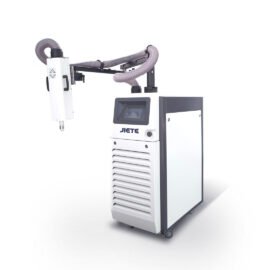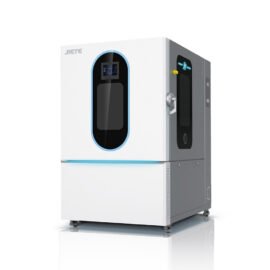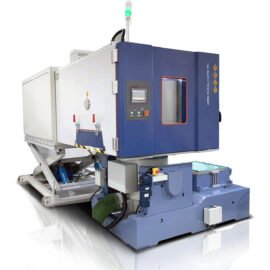PRODUCTS
Categories
- Oven (1)
- Temperture&Humidity Chamber (3)
- Combined Environmental Test Chamber (1)
- High&Low Temperature Chamber (1)
- Low Temperature&Humidity Chamber (1)
- Temperature Cycling Chamber (1)
- Thermal Shock Chamber (1)
- Alitute Test Chamber (1)
- Salt Spray Test Chamber (1)
- Heat Flow Meter (1)
- Sand&Dust Test Chamber (1)
- Rain Test Chamber (6)
Industry
INDUSTRIES WE SERVE
Introduction
Semiconductor devices must undergo rigorous environmental testing to ensure stability, reliability, and performance under various extreme conditions. These tests simulate real-world stresses such as thermal cycling, humidity, vibration, and thermal shock that components may encounter in automotive, aerospace, and consumer electronics applications.
Products Tested
Semiconductor wafers
Integrated circuits (ICs)
Microcontrollers
DRAM/NAND memory
Chip packaging materials
BGA substrates, PCBs
Test Conditions
High Temperature: +85°C ~ +150°C, long-term burn-in and aging
Low Temperature: -40°C ~ -70°C, cold start and low-temp operation
Temperature Cycling: -40°C ~ +125°C, ramp rate 3°C/min or higher
Humidity Testing: 85°C / 85% RH for 1000h (Highly Accelerated Stress Test – HAST)
Thermal Shock: -65°C ⇄ +150°C, dwell time 15min, transfer <10 sec
Vibration & Mechanical Shock: 10~2000 Hz, up to 30g sinusoidal/random; half-sine shock 100g/6ms
Dust-proof (if open-air packaging): IEC 60529 IP5X/IP6X conditions
Optional: Cleanroom compatibility (ISO Class 5–7 environment)
Testing Standards
JEDEC JESD22-A104 – Temperature cycling
JEDEC JESD22-A110 – HAST humidity testing
MIL-STD-883 – Microelectronic device reliability test procedures
IEC 60749 – Semiconductor device mechanical/environmental tests
ASTM F1980 – Accelerated aging of packaging components
Introduction
Optical communication components—such as optical modules, fiber connectors, and transceivers—must maintain transmission quality and stability under diverse environmental stresses. These components are widely used in telecom base stations, data centers, aerospace, and 5G infrastructure, where they must endure heat, humidity, vibration, and contamination risks.
Products Tested
Optical transceivers (SFP, QSFP, etc.)
Fiber optic connectors & jumpers
Laser diodes / VCSEL
Photodetectors
Optical splitters and modulators
Optical amplifiers (EDFA, SOA)
Test Conditions
High Temperature Storage: +85°C ~ +125°C, duration 240–1000h
Low Temperature Storage: -40°C ~ -60°C
Temperature Cycling: -40°C ⇄ +85°C, ramp rate 3°C/min, 500–1000 cycles
High Temperature/Humidity Bias: 85°C / 85%RH for 1000h (unpowered/powered)
Thermal Shock: -40°C ⇄ +85°C with <20s transfer, 300–500 cycles
Salt Spray: 35°C, 5% NaCl, 48h exposure (for outdoor fiber components)
Dust Test: Simulate dusty deployment environments (e.g., IP5X)
Vibration: 10–500 Hz, up to 3g RMS random, 3 axes, 30–120min
Optional: Condensation or icing test for exposed connectors
Testing Standards
Telcordia GR-468-CORE – Optoelectronic component reliability
IEC 61300-2 Series – Basic test procedures for fiber optic components
MIL-STD-810G/H – Environmental and mechanical simulation
ISO 9022 – Environmental testing of optical instruments
IEC 60068 – Basic environmental testing standards
Introduction
In biological and life science research, precise environmental control is essential for ensuring experimental reliability and reproducibility. From incubation of biological samples to long-term storage or stress simulation, test chambers must provide stable, controllable climates with high accuracy.
Products Tested
Cell culture media & reagents
Biological samples (tissues, cells, enzymes)
Incubators and lab refrigerators
Diagnostic kits and sensors
Experimental medical devices
Lab consumables (e.g., plasticware under storage validation)
Testing Standards
ICH Q1A (R2) – Stability testing of pharmaceutical/biological products
ISO 17025 – Laboratory competence for calibration and testing
FDA 21 CFR Part 58 – Good Laboratory Practices (GLP)
EN 60068-2-78 – Damp heat, steady state
WHO Guidelines on Biological Stability Testing
Test Conditions
Constant Temperature Incubation: +5°C ~ +60°C, ±0.5°C precision
Humidity Control: 40% ~ 95% RH, stability ±3%RH
Temperature-Humidity Profiles: e.g., 37°C / 95%RH for cell culture
Refrigerated Storage: +2°C ~ +8°C or -20°C (for enzyme/sample stability)
Freezing Test: -40°C ~ 0°C (transportation or cryo-compatibility testing)
Photoperiod Simulation (optional): 24h light cycle 300-1000 lux
CO₂ or O₂ Control (optional): For advanced biosimulation chambers
Stability Testing: According to ICH guidelines, e.g., 25°C / 60%RH for 6–12 months
Introduction
Military-grade equipment must endure extreme environmental stress to ensure functionality in harsh and unpredictable operational conditions such as desert heat, arctic cold, high altitudes, salt-laden coasts, or airborne missions. These tests verify durability, stability, and mission-critical reliability under combat-like scenarios.
Products Tested
Communication modules & control units
Military computers & onboard electronics
Navigation/guidance systems
Ruggedized enclosures & connectors
Batteries, power modules, UPS
Avionics & missile components
Testing Standards
MIL-STD-810H – Environmental engineering considerations and lab tests
MIL-STD-202 – Tests for electronic and electrical component parts
MIL-STD-461 – Electromagnetic interference (EMI) and susceptibility
DEF STAN 00-35 (UK) – UK MoD environmental testing standards
NATO AECTP-300 / 400 – Climatic and mechanical test procedures
Test Conditions
High Temperature Operation: +55°C ~ +85°C (sometimes up to +125°C), operating duration 8–48h
Low Temperature Operation: -40°C ~ -55°C, test duration 8–24h
Thermal Shock: -55°C ⇄ +85°C or -65°C ⇄ +125°C, dwell time ≥30min, transfer <10s, 50–100 cycles
Humidity Testing: 30°C ~ 60°C / 90% ~ 98%RH, duration 10 days (MIL-STD-810H Method 507.6)
Altitude/Low Pressure: 4572 m (15,000 ft) or 15.5 kPa at -40°C or +55°C
Sand & Dust: Blowing sand (1.5g/m³ at 40–60°C), blowing dust (10g/m³, <150μm)
Salt Fog: 35°C, 5% NaCl mist, exposure 48–96h
Rain Test: Simulate driving rain at 276 kPa pressure and wind up to 30 m/s
Vibration & Shock: Sinusoidal up to 30g, random profile (MIL-STD-810H Method 514.8), mechanical shocks 40g/11ms or higher
Optional: Icing/freezing rain, solar radiation, fungus, gunfire vibration
Introduction
As energy storage becomes critical in electric vehicles, aerospace, and portable electronics, battery safety and performance must be validated under extreme environmental conditions. Environmental simulation chambers are used to assess thermal stability, mechanical integrity, and long-term reliability.
Products Tested
Lithium-ion cells (cylindrical, pouch, prismatic)
Battery modules and packs
Battery Management Systems (BMS)
Supercapacitors
Solid-state batteries
Explosion-proof battery boxes
Testing Standards
UN 38.3 – Lithium battery transportation testing
IEC 62133 – Safety for portable sealed batteries
UL 1642 / UL 2054 – Lithium cell and pack safety
GB/T 31467 / 31485 / 35590 – Performance, abuse, and thermal testing for EV batteries
SAE J2464 / J2929 / J1797 – Abuse and vibration tests for automotive applications
ISO 12405 – Lithium-ion battery systems for electric vehicles
IEC 62660-2 – Reliability tests for automotive Li-ion cells
Test Conditions
High Temperature Exposure: +55°C to +85°C, for 8–168 hours
Low Temperature Exposure: -20°C to -40°C (some tests require down to -50°C)
Thermal Cycling: -40°C to +85°C, ramp rate ≥3°C/min, 100–500 cycles
High Humidity Test: 40°C to 60°C / 90–95%RH, for 96–500 hours
Thermal Runaway Simulation: Step heating up to 130°C–200°C in explosion-proof chambers
Altitude Simulation: 11.6 kPa (simulating 15,240 meters / 50,000 ft), storage condition
Vibration: 7Hz to 200Hz, amplitude 1mm or 1.5g, 3 axes, 3 hours each
Salt Spray: 35°C, 5% NaCl solution, 48–96 hours
Impact, Crush, Nail Penetration: Conducted in reinforced, explosion-proof environment
Introduction
Aerospace components are exposed to some of the most extreme environmental conditions—including high-altitude pressure, rapid thermal shifts, and severe vibration—whether in flight or space environments. Comprehensive testing ensures functional reliability, safety, and material stability in mission-critical applications.
Products Tested
Avionics and control modules
Satellite components
Power systems and batteries
Structural panels and composite parts
Sensors and actuators
Cables, connectors, and insulation materials
Testing Standards
RTCA DO-160 – Environmental conditions for airborne equipment
MIL-STD-810H – Environmental engineering for military aerospace systems
NASA-STD-7001 / 4005 – Flight hardware environmental and structural testing
IEC 60068-2 Series – General environmental test methods
ASTM E595 – Outgassing characteristics in vacuum for spacecraft materials
Test Conditions
High Temperature Operation: +70°C to +125°C (equipment bay, avionics)
Low Temperature Operation: -55°C to -70°C (high-altitude or space scenarios)
Thermal Cycling / Shock: -65°C to +100°C or wider, ramp rate 5–10°C/min, 100–300 cycles
Vacuum / Low Pressure: <1 kPa to simulate >20,000 m altitude or space vacuum
Humidity Testing: 25°C to 60°C / 85–95%RH, duration 240–1000 hours
Solar Radiation (optional): UV exposure equivalent to AM0 spectrum, up to 1.4 kW/m²
Rain, Fog, and Condensation: Simulated ground handling or coastal deployments
Salt Spray: 35°C, 5% NaCl, 48–96 hours for naval or launch pad environments
Vibration / Shock Testing: 5–2000 Hz, up to 30g sinusoidal/random; shock pulses up to 50g
Combined Environment Tests: Simultaneous thermal, vacuum, and vibration loading
Introduction
Automotive components must maintain functionality and safety across extreme conditions including temperature variation, humidity, vibration, dust, salt corrosion, and thermal shocks. Environmental testing is crucial for validating the reliability of systems used in traditional, electric, and autonomous vehicles.
Products Tested
Power batteries and battery management systems (BMS)
In-vehicle electronics (ECUs, sensors, infotainment units)
Wire harnesses and connectors
EV drive modules and inverters
HVAC components
Interior and exterior materials (dashboard, lights, seals)
ADAS sensors (radar, LiDAR, cameras)
Testing Standards
ISO 16750 Series – Environmental conditions for electrical and electronic equipment in road vehicles
SAE J1455 / J1211 – Vehicle environmental practices for on- and off-road applications
IEC 60068-2 Series – Standard environmental testing procedures
LV 124 / LV 148 – OEM standards (e.g., Volkswagen, BMW) for electrical components
GB/T 31485 / GB/T 28046 – Chinese national standards for EV battery and automotive electrical systems
UN ECE R100 / R136 – Battery safety regulations for electric vehicles
ISO 20653 – Protection against dust and water (IP ratings)
Test Conditions
High Temperature Soak: +80°C to +125°C, up to 1000 hours for heat aging
Low Temperature Operation: -40°C to -20°C for cold start behavior
Thermal Shock: -40°C ⇄ +85°C or wider, transition time <10s, 100–500 cycles
Temperature-Humidity Cycling: 10°C ~ 65°C / 80–95%RH, 10–20 cycles
Combined Stress Testing: 4-in-1 chambers simulating temp, humidity, vibration, and electrical load
Dust Exposure (IP5X / IP6X): Dry sand or talc flow at 60°C for 8h
Salt Spray (Corrosion Resistance): 35°C, 5% NaCl solution, 96–240 hours
Condensation Testing: 60°C / 95%RH followed by cool-down, simulating garage conditions
Mechanical Vibration: 10–2000 Hz random vibration, 3 axes, 8 hours each
Water Ingress (IPX4–IPX9K): High-pressure jet and immersion simulation for engine bay and underbody components
Introduction
Construction materials and building systems must endure diverse environmental exposures including temperature extremes, moisture ingress, UV radiation, and freeze-thaw cycles. Environmental simulation testing ensures structural integrity, safety, and long-term weather resistance for residential, commercial, and infrastructure applications.
Products Tested
Insulation materials (foam boards, mineral wool)
Exterior coatings, sealants, and adhesives
Concrete samples and fiber-reinforced composites
Roofing membranes and waterproofing layers
Structural panels, glass, and window assemblies
HVAC units and smart building components
Testing Standards
ASTM C666 – Freeze-thaw resistance of concrete
ASTM D543 / D4585 / D5229 – Chemical resistance, moisture conditioning
EN 13501 – Fire classification of building products
ISO 9227 – Salt spray corrosion testing
DIN 50018 – Sulfur dioxide corrosion simulation
GB/T 23446 / 24492 – National standards for waterproof and insulation materials
Test Conditions
High Temperature Aging: +60°C to +90°C, sustained exposure for 500–1000 hours
Low Temperature Exposure: -20°C to -40°C for cold-weather durability
Freeze-Thaw Cycling: -20°C ⇄ +20°C, 25–100 cycles to assess cracking and delamination
Humidity Testing: 25°C to 60°C / 85–95%RH, up to 1000 hours for mold and moisture resistance
Water Ingress / Rain Simulation: IPX4–IPX6 test conditions, up to 10 L/min per nozzle
UV Resistance: 280–400 nm spectrum, 0.7–1.4 W/m²/nm, up to 1000 hours (QUV equivalent)
Salt Spray / Fog Test: 35°C, 5% NaCl, 48–96 hours for coastal corrosion evaluation
Thermal Expansion Testing: Simulate differential heating to test joint integrity
Introduction
Scientific research across disciplines—from materials science to climate modeling—relies on controlled, repeatable environmental testing to validate hypotheses and prototypes. Precision environmental chambers provide the stability and configurability required for long-duration experiments and specialized test conditions.
Products Tested
Experimental devices and instruments
Material and chemical samples
Biological and medical prototypes
Climate impact samples (e.g., polymers, soils)
Sensor systems under calibration
Custom test rigs and assemblies
Testing Standards
ISO 17025 – Laboratory testing and calibration competence
ASTM E595 – Outgassing in vacuum environments (material testing)
EN 60068-2 Series – Environmental test procedures
ICH Q1A – Stability testing protocols for pharmaceuticals and life sciences
ASTM D618 / E171 – Conditioning of plastics and materials
CFR 21 Part 58 – GLP compliance for preclinical research
Test Conditions
Constant Temperature: +10°C to +80°C, precision ±0.5°C
Low Temperature: -70°C to -20°C for storage or simulation
Humidity Range: 20% to 95%RH, stability ±2.5%RH
Programmable Profiles: Custom temperature/humidity ramps, dwell cycles, or seasonal simulation
Freeze/Thaw Testing: -40°C ⇄ +20°C, cyclic, for chemical and structural integrity
Thermal Stress Testing: Ramp rate up to 5°C/min, stress gradients
Condensation Testing: Saturation and dew point conditions for moisture impact studies
Gas Control (optional): CO₂, O₂, or inert gas purge capability for controlled atmospheres
Introduction
Green energy systems, such as solar, wind, and hydrogen technologies, must withstand prolonged exposure to outdoor environments including extreme heat, humidity, UV radiation, and corrosive conditions. Environmental simulation testing helps verify reliability and performance for long-term field deployment.
Products Tested
Photovoltaic (PV) modules and solar cells
Wind turbine components (blades, control systems)
Hydrogen fuel cells and tanks
Inverters, converters, and battery storage units
Power electronics and protective enclosures
Testing Standards
IEC 61215 – Design qualification for PV modules
IEC 61730 – Safety testing for PV modules
ISO 50001 – Energy management and performance
IEC 60068-2 Series – Environmental test procedures
UL 1703 / UL 61730 – PV module safety and construction
IEC 62852 / 62930 – Connectors and cables for green energy systems
Test Conditions
High Temperature Exposure: +60°C to +85°C, long-term heat aging
Low Temperature Exposure: -40°C to -20°C, cold start validation
Thermal Cycling: -40°C to +85°C, ramp rate ≥5°C/min, 200–600 cycles
Damp Heat Test: 85°C / 85%RH, 1000–2000 hours (PV standard)
UV Exposure (Solar Radiation): 280–400nm range, 60 W/m² or higher, up to 2000 hours
Salt Mist Corrosion: 35°C, 5% NaCl spray, 96–168 hours (coastal environments)
Rain and Water Ingress: IEC60529 IPX4–IPX6 rain simulation
Dust & Sand Resistance: 1.5–2 g/m³ dust at 60°C for 8 hours (wind turbine electronics)
Mechanical Stress Simulation: Thermal + vibration + humidity combined stress testing
Introduction
Advanced materials—including polymers, composites, metals, and nanomaterials—are subject to thorough environmental testing to evaluate performance, durability, and physical changes under stress. Simulation chambers are essential in validating material behavior under accelerated aging, thermal cycling, and humidity exposure.
Products Tested
Polymer films and sheets
Reinforced composites
Advanced ceramics
Nanomaterials and coatings
Metals and metal alloys
Adhesives and resins
Testing Standards
ASTM E96 / ISO 2528 – Water vapor transmission rate
ISO 11357 – Differential Scanning Calorimetry (DSC) for thermal transitions
ASTM D638 / ISO 527 – Tensile strength of plastics
DIN 50018 – Sulfur dioxide corrosion (industrial atmosphere)
IEC 60068-2 Series – Environmental testing of material samples
ASTM D543 – Chemical resistance of plastics
GB/T 2423.1 / 2423.3 – Chinese standards for temperature and humidity testing
Test Conditions
Thermal Cycling: -40°C ⇄ +120°C, ramp rate 3–5°C/min, up to 1000 cycles
Humidity Testing: 60% to 95%RH at 25°C–60°C, long-term exposure for swelling and delamination
High-Temperature Aging: +80°C to +150°C for polymer degradation and oxidation testing
Freeze-Thaw Simulation: -40°C ⇄ +20°C, typically 25–100 cycles
Corrosion Test (SO₂ or Salt Mist): 35°C, 5% NaCl or SO₂ atmosphere, up to 96h
UV Exposure (Accelerated Weathering): 0.7–1.4 W/m² at 340nm, up to 1000h
Water Absorption and Expansion: Soaking or condensation at elevated humidity and temperature
Optional Combined Testing: Temperature, humidity, and mechanical stress simultaneously
Introduction
Consumer electronic products are expected to perform reliably across a wide range of daily-use conditions, including heat, cold, humidity, drops, sweat, and transportation. Environmental testing ensures quality, durability, and safety for devices used in homes, offices, and mobile scenarios.
Products Tested
Smartphones and tablets
Smartwatches and wearables
Laptops and handheld devices
Wireless earbuds and headsets
Smart home devices (cameras, speakers, thermostats)
Charging adapters and power banks
Printed circuit boards (PCBs) and IC modules
Testing Standards
IEC 60068-2 Series – Environmental testing for electronic devices
IEC 60529 / ISO 20653 – IP rating tests (dust and water ingress)
JEDEC JESD22 Series – Reliability stress tests for semiconductors
MIL-STD-810H (selectively applied) – For ruggedized consumer electronics
GB/T 2423 Series – Chinese national environmental test methods
ASTM D5276 / D4169 – Drop, impact, and packaging performance
IEEE 1625 / UL 2054 – Battery reliability and charging system safety
Test Conditions
High Temperature Storage: +60°C to +85°C for 72–500 hours
Low Temperature Operation: -20°C to -40°C for cold-start or transport simulations
Temperature Cycling: -20°C ⇄ +60°C, 3°C/min ramp, up to 100 cycles
Humidity Test: 40°C / 93%RH, or 60°C / 90%RH for 96–240 hours
Thermal Shock: -40°C ⇄ +70°C with ≤10s transition, 50–100 cycles
Sweat and Corrosive Atmosphere: Artificial sweat test at 37°C, or SO₂ exposure
Dust Resistance (IP5X/IP6X): Talc exposure at 60°C for 8h
Water Resistance (IPX4–IPX8): Splashing, rain, immersion (up to 1m for 30 min or more)
Drop / Impact Testing: 1.0–1.8 m drop to hard surface, multiple orientations
Sunlight/UV Aging: 0.7 W/m² at 340 nm for 200–1000h simulating indoor light exposure



















